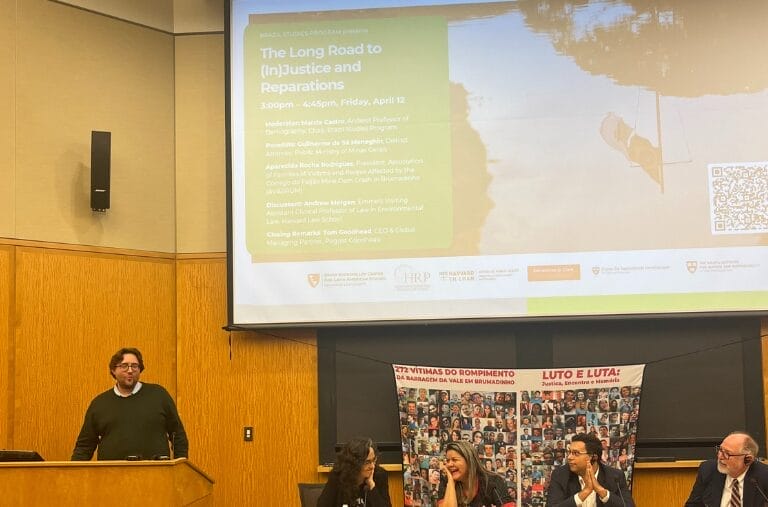Managing exposure to legal risk is a mounting challenge for corporations, with significant resources devoted to the exercise every year. Company commitments to ESG principles are now commonplace. While environmental and governance strategies are nothing new, the field of ESG legal risk management is growing exponentially. The entrenchment of ESG principles across sectors and the increased scrutiny of company practices means that it’s no longer possible for operations and corporate governance to proceed in a ‘business-as-usual’ fashion. The burden is now very much on companies to regulate their environmental and societal impacts. Managing ESG legal risks is becoming an increasingly important part of business management.
From the 2021 decision to hold Shell legally liable for contributing to climate change, to the A$192.5mn oil spill settlement paid by PTTEP Australasia in 2022 over damages to the Timor Sea; litigation is increasingly being seen as an enforcement mechanism for ESG commitments, with significant consequences for ESG legal risk.
A theoretical foundation
To explore this intersection, it’s helpful to go back to basics. Let’s look at the economic foundations of what we understand to underpin ESG risk management.
One of the key principles that students of liberal market economics study is the Coase Theorem. Coase’s Theorem is the basis for studying the enforcement of property rights. It states that under perfect market conditions, private bargaining can lead to the most efficient allocation of resources. In other words, if transaction costs are low and property rights are well-defined, individuals can negotiate and reach mutually beneficial agreements that maximize overall outcomes for both parties. Essentially, the theorem proposes that parties are better off negotiating by themselves rather than involving a bureaucrat when disputing over property rights. Even when they’re disputing over the externalities caused by their economic activities.
So, imagine this fictional, textbook example. A dispute between a noisy factory and a neighbouring community impacted by noise pollution. Coase’s Theorem asserts that under perfect market conditions, these two parties (the industry and the affected community) should be able to bargain and reach a mutually beneficial outcome without government intervention.
The theorem foresees two possible scenarios. But, for both of them, the first step would be to assess the market value of each activity. If the market value of the factory’s outputs (its production) is quantified as being higher than the market value of the damage caused to the community, the factory should be able to continue its noisy, yet valuable activities, and use its revenue to cover the damages experienced by their neighbours.
However, according to the theory, if the market value of damages to the community is deemed higher than the value of the factory’s output, the factory should stop its noisy activities, provided that the neighbours would accept to pay the owner an amount that would compensate them for the costs of stopping production.
Now, of course, this doesn’t happen in real life. This is a theory. Just as many of the liberal economic models, both outcomes depend on something that doesn’t exist in reality – perfect market conditions. Optimal market conditions would include the absence of power imbalances between the parties, making the factory owners and their neighbours true equals. The theory also assumes the absence of transaction costs, enabling the parties to continue the bargaining process freely, at no cost, and for as long as necessary, as the parties would also have no liquidity constraints that would rush a decision. Furthermore, in this perfect market, information would be complete and symmetric. What one party knows, the counterpart knows as well. There is total informational transparency on both sides.
From theory to reality
Leaving the textbooks aside, we can apply the Coase Theorem to a real-world scenario. Switch the noisy factory to a mining company in Brazil polluting a river with toxic chemical byproducts of its activities. On the opposing side, think of a neighbouring community that relies heavily on the river.
These neighbours include fishermen, reliant on the river to fish and provide for their communities. They include families and children, for whom the water was a place of leisure and enjoyment. They include Indigenous and Traditional communities for whom the river is considered sacred. They have lost access to the river for all their essential economic, social and spiritual needs.
If we follow Coase’s Theorem, under perfect market conditions, these two parties could reach an agreement, bargaining to achieve an optimal outcome for both, based on which side has the property rights with higher market value. However, when we take this principle out of the abstract and bring it into the real world, it’s clear that the logic of this system doesn’t hold. The truth is, that while an efficient outcome might be reached under ‘perfect market conditions’, these don’t exist.
Reflecting on this very real example of a mining company responsible for environmental pollution in a culturally rich and biodiverse Brazilian community, we can clearly see the power imbalance between parties. We would never reasonably conceive of an Indigenous community leader knocking on the door of the factory to demand reparations. Similarly, we would hardly believe that the mining company would respond with full transparency about the extent of their damage to the environment. Furthermore, we would never imagine that the community would be able to afford to bargain with the mining company, in parity of arms for as long as necessary.
This is the reality of where we find ourselves today, and why corporate accountability for externalities causing harm to the environment and society is only achieved after taking powerful companies to the judiciary.
Levelling the playing field
In a modern application of the Coase Theorem, studies have shown that the courts can be a powerful tool in levelling the playing field between defendant and claimant; imposing litigation costs to both sides to bargain for a settlement or a favourable court decision. However, the issue with judicial intervention remains the question of parity. How can we ensure that parties are able to come to the table, or to the courts, with more equality?
Group litigation, and funding for these kinds of judicial disputes is part of how we are doing this at Pogust Goodhead. We advocate for millions across the world who have been affected by environmental harms caused by large corporations. By giving claimants the chance to bring their case collectively, with financial support and protection as they enter into negotiations, we can use litigation to shift the scale closer towards equality.
At the heart of this concept is bargaining power. The prospect of group litigation – allowing people who would otherwise be incapable of pursuing legal remedies to do so at no financial risk to themselves – is among about the most effective way of holding powerful corporations to account over their actions and responsibilities to the environment and to communities. It’s also significant in its potential to prompt companies to proactively adjust their business models in light of ESG risks – ultimately encouraging better corporate behaviour and reducing the chances of future infringements on environmental and human rights.
Other forces associated with ESG legal risks also push companies to adapt. Reputational costs, consumer preferences, the emerging scientific evidence on climate related damages and the growing trend towards regulation, are all powerful levers through which to enforce greater adherence to ESG principles. All of these tools and pressure points combined, are shaping a new landscape of corporate accountability and improved governance, and the businesses that don’t adapt will lag behind.
How we’re doing this at Pogust Goodhead
One of our largest cases at Pogust Goodhead concerns the collapse of the Fundão mining dam in Mariana, Brazil. In 2015, over 50 million cubic metres of toxic tailings were dumped into the Rio Doce. The disaster killed 19 people and affected the lives of hundreds of thousands more. It has been described as Brazil’s worst ever environmental disaster. We are representing nearly 700,000 Brazilians affected by the collapse against Anglo-Australian mining giant, BHP, who along with Brazilian mining company Vale, was responsible for the dam’s operations.
As we prepare to go to trial this October, this is now the largest group litigation of its kind in the English courts. Recent estimates place the damages value at £36 billion. With its sheer size, the potential of this case to transform corporate accountability on ESG through its precedent cannot be overstated.
In another significant case, demonstrating a similar asymmetry between claimant and defendant, we are also representing over 1,600 orange growers in Brazil against the powerful Cutrale family for engaging in unlawful cartel practices to control the export of orange juice to the international market. Pushing many producers out of the industry, the remaining independent farmers were forced to accept the cartel’s harsh terms for buying their produce, leading to significant financial losses. The English courts have accepted jurisdictions, and we are preparing to go to trial in the near future.
This ongoing litigation has the potential to cause significant financial and reputational damage to the defendants. Damages are estimated at around USD$2.5 billion. The fact that this case refers to the price-fixing scheme undertaken by the Cutrales, starting more than 20 years ago, further illustrates that companies need to be increasingly attuned to the risk of litigation, not just for activities taking place today, but also for infringement that may have taken place in the past.
Group litigation and ESG legal risk
There is no shortage of cases concerning corporate malpractice. But the encouraging thing is that the market for litigation is growing exponentially. Just last year, we reached the largest litigation funding deal in history. The deal, worth USD$552.5 million, will finance a swathe of environmental cases. This means that our work, really is only just getting started. Corporations need to sit up and take notice about how seriously they’re taking their commitments to ESG principles.
So, whether it’s fishing communities in Peru, seeking compensation from a Spanish-owned oil company that destroyed their coastal waters; or an Indigenous community living in Barcarena, Brazil, suing SALIC, the Saudi Sovereign Wealth Fund for its role in controlling one of the largest protein producers in the world, or communities taking the chemical company Norsk Hydro to court over aluminium pollution in Para – the landscape of corporate accountability is changing rapidly. The status quo can no longer be taken for granted and the cost of ignoring ESG legal risks is skyrocketing.
At the heart of all these cases, is essentially, the principle that citizens should have the right to challenge corporate wrongdoing, and have their rights, and the rights of their land, respected. Group litigation and finance for it, is helping us enforce these rights.
The implications for how corporations view ESG legal risk, is significant. The risk of being held to account over environmental wrongdoing is now so great, it’s no longer an option not to have a comprehensive strategy for risk management. Our hope at Pogust Goodhead is that eventually, it will become virtually impossible for businesses to pursue harmful practices, under the threat of reprisal from firms like ours.
Ana Carolina Salomão is a Partner and Chief Investment Officer at Pogust Goodhead









